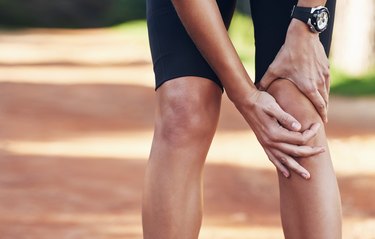
An injury or stress to the joint may cause knee swelling after exercise. It is common to have overuse injuries from activities such as running. While you may be able to treat swelling at home with rest, consult your doctor if the swelling continues as it may be a more serious injury requiring additional treatment.
Tip
Knee swelling after exercise may be caused by runner's knee, a knee strain or sprain, or torn cartilage. These conditions can usually be treated with rest, physical therapy and over-the-counter anti-inflammatory medication, but more severe cases may require surgery.
Video of the Day
Swelling From Runner's Knee
Patellofemoral pain syndrome, or runner's knee, may cause knee swelling after exercise. This condition causes pain around the kneecap. Other symptoms may include stiffness and a clicking or grinding sound when you move the joint.
Video of the Day
Runner's knee is commonly caused by overuse or a misaligned patella due to incorrect leg alignment or muscle weakness. In some cases, you may also have chondromalacia patella, which is the breakdown of cartilage under the kneecap.
You may be able to treat runner's knee by using the RICE method — rest, ice, compression and elevation — until the pain has resolved. Depending on the level of pain and damage to the knee, other treatment options include physical therapy, shoe inserts to correct alignment and surgery.
Torn Knee Cartilage
There are two pads of cartilage in the knee to cushion the joint. If you have a tear in the cartilage, called the meniscus, you will experience pain and swelling on either the inner or outer knee, depending on which pad has been injured.
A torn meniscus may be caused by trauma, such as twisting the knee, overuse or as a normal degenerative part of aging. In many cases, patients can recover with rest, anti-inflammatory medications and exercises to strengthen the muscles that support the knee joint. Your doctor may recommend a brace to support the knee.
If the knee becomes locked in place from the torn cartilage, or if the pain does not improve, surgery may be required to repair the torn meniscus.
Other Knee Pain Causes
Other causes of knee pain and swelling after exercise include ligament sprains and bursitis. Like the other injuries, these conditions may be caused by trauma, overuse, muscular weakness or imbalance or incorrect footwear. Treatment for a sprain includes rest, anti-inflammatory medication, physical therapy and, in some cases, surgery.
Bursitis is the swelling of the bursa, the sac of fluid that provides a cushion between your bones and tendons. Treatment options include anti-inflammatory medications, steroid injections and surgery.
Preventing Knee Swelling
Prevent knee swelling and injury by avoiding overtraining. Warm up before training and be sure that you increase your exercise intensity and duration slowly. Include strengthening exercises in your fitness routine to keep your body strong and in correct alignment to support the joints. Wear properly fitted shoes that are comfortable and support your feet.
If you do experience pain, take time to rest the joint. Try low-impact exercises, such as swimming or walking, to maintain your fitness while you recover.
Warning
If the pain and swelling are severe or do not improve, contact your doctor. Continuing to train on an injured knee may cause further damage and increase the recovery time.
- American Academy of Orthopaedic Surgeons: "Patellofemoral Pain Syndrome"
- Mayo Clinic: "Swollen Knee"
- Rush University Medical Center: "5 Tips for Preventing Knee Pain"
- University of Washington Orthopaedics and Sports Medicine: "Torn Meniscus"
- Harvard Health Publishing: "Knee Sprain"
- Drugs.com: "Knee Bursitis"
Is this an emergency? If you are experiencing serious medical symptoms, please see the National Library of Medicine’s list of signs you need emergency medical attention or call 911.